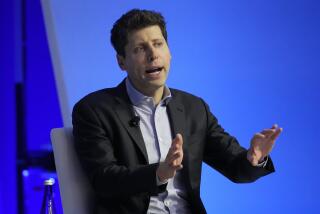Book Review : Getting Machines to Think as a Human
- Share via
Thinking Machines: The Evolution of Artificial Intelligence by Vernon Pratt (Basil Blackwell: $19.95; 254 pages, illustrated)
Artificial intelligence--the effort to get computers to think--has been the object of much attention in recent years, and there has been no shortage of books extolling its virtues and promise. Most of them have been long on hype and short on results, just as the field itself has been.
Vernon Pratt’s book, “Thinking Machines,” comes at the subject from a different point of view. He traces the history of the idea of thinking (a fairly modern development) and of the idea of mechanizing thought from the 17th to the 20th Century.
He shows how the goal of artificial intelligence is part and parcel of the scientific and mathematical world view that took charge of thought three centuries ago. Bolstered by unparalleled success, this view is still in control.
Pratt tells his story by focusing on three men--G. W. Leibniz, the 17th-Century German philosopher who got the idea of automating calculation; Charles Babbage, the 19th-Century British inventor who designed (but didn’t quite build) a mechanical device that was the forerunner of modern electronic computers, and Alan Turing, the 20th-Century British mathematician who in 1936 realized that computers could be used for much more than computing. (Turing, who committed suicide in 1954 at the age of 41, is currently the subject of a Broadway play, “Breaking the Code.”)
Rise of Mathematics
Woven through their stories is a rich intellectual history that starts with the rise of mathematics as a powerful tool not just for science, but for commerce and navigation.
This theme recurs throughout the book. Science frequently advances by the need to solve practical problems. Engineering is a powerful motivator to theoretical advance. But theoretical advances, once made, can have powerful impacts beyond their immediate fields.
“The bursting forth of mathematics was accompanied by, and did much to encourage, the idea that mathematical thought constituted the paradigm of thought in general,” Pratt writes. This notion gave rise to the general idea of formalism, which holds that form can be distinguished from content, as, for example, grammar can be studied separately from the meaning of sentences.
Formalism means that things can be studied and manipulated abstractly. Its debt to mathematical thinking is clear. Automatic calculators follow from this idea. Pratt says:
“In the face of the enormous development effort that has engaged some of the best minds, some of the most sophisticated techniques and some of the biggest money from the 1940s on, we need to remind ourselves of the awesomely simple root object of it all: to add, subtract, multiply, and divide, more quickly. . . . Part of the fascination of the modern machine is the utter simplicity of its basic principles seen against the background of its tremendous powers.” Add to this, the notion that every thought, every feeling, every sensation that a human being is aware of represents some identifiable state of the brain, and that these brain states may also be manipulated, and glimmerings of artificial intelligence begin to stir. Most contemporary work in artificial intelligence involves efforts to get machines to do this manipulation.
Philosopher Skeptical
Pratt, a philosopher at Lancaster University in Britain, is skeptical about whether the ultimate goal of artificial intelligence--building a brain--can succeed. So far, the artificial intelligensia has achieved limited successes that cannot be generalized into a brain.
While not ruling out the possibility (the history of science is littered with predictions of impossibility that were soon proved wrong), Pratt doubts that every dimension of human mentality can be captured by a machine. “Feeling angry, miserable, guilty, tired, or hopeful--these do not seem to be construable in terms of the manipulation of uninterpreted symbols,” he writes.
And yet, the possibility cannot be ruled out. After all, if there is a physical state of the brain that corresponds to every facet of mind, then it is at least theoretically possible to mimic that state in a machine. On the other hand, if there is something other than flesh and blood inside our skulls, what is it?
Neither of these approaches provides an altogether satisfactory explanation of the mind and the brain, though it is hard to imagine how there can be anything other than flesh and blood. In the end, it’s all chemistry. And there the matter rests.
Pratt deftly shows the provenance of these crucial questions of mind and machine. As logic and mathematics have blended together in the modern era, the idea that the whole process can be automated has proved irresistible. And yet, no one has been able to bring it off. Though machines can do arithmetic to beat the band, and an even play chess very well, they still cannot think.
Pratt’s book starts off slowly, and it is perhaps a tad too detailed for many readers. But it offers a persuasive and compelling argument for the idea that a machine capable of reasoning has its roots in the rise of science. A mechanical world view leads to plans for mechanical thought.
More to Read
Sign up for our Book Club newsletter
Get the latest news, events and more from the Los Angeles Times Book Club, and help us get L.A. reading and talking.
You may occasionally receive promotional content from the Los Angeles Times.










